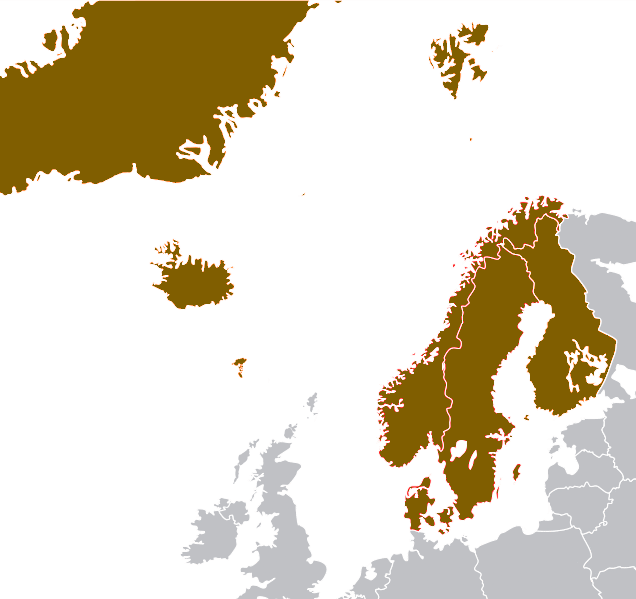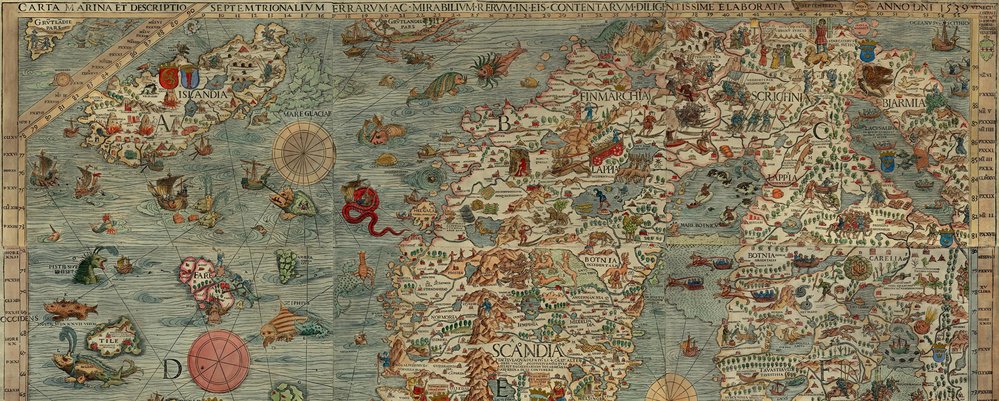The Nordic region
The Nordic region, or Norden, may be defined as consisting of the five sovereign states Denmark, Finland, Iceland, Norway and Sweden, plus the three autonomous territories connected to these states: the Faroe Islands and Greenland (Denmark) and Åland (Finland). These states are widely considered to form a distinctive region by virtue of their strong historical ties and the tradition of inter-governmental co-operation across national boundaries.

Norden means literally ‘the North’ in the Danish, Norwegian and Swedish languages, and ‘northern’ was sometimes used as a designation for the region, at least up to the 1950s.
Scandinavia vs the Nordics
The terms Scandinavia and Scandinavian are often used as synonyms for Norden and Nordic in English. Some insist that Scandinavia refers just to Denmark, Norway and Sweden (or even just to the Norwegian-Swedish peninsula), and does not include Finland or Iceland. Although the term Scandinavia is still used to refer to the whole region, Nordic is becoming increasingly common.
A flexible concept
Norden or the Nordics is a flexible concept, which has changed its meaning and its geographical boundaries in different times and contexts and will doubtless continue to do so. The term may be grounded in joint politics and history, it may invoke a particular genre of literature or art, or it may be a branding exercise, attempting to unite countries which are in fact quite different.
The boundaries of Norden have sometimes stretched beyond the core of the region. For example, there have been important historical connections between Norden and parts of the British Isles, which were widely debated in the context of the 2014 referendum on Scottish independence. Could a potentially independent Scotland be considered as a Nordic country; or could say the Shetland Islands be considered as Nordic region similar to the Faroe Islands? At other times, Norden might have included territories on the southern shore of the Baltic, for example during the brief period of Estonian independence after 1918 and again during the 1990s, when the disappearance of the iron curtain triggered interest in the idea of a Baltic Sea region. In the eighteenth century the concept of ‘the north’ included Russia and Poland as well as what are now the Nordic countries.
One of the paradoxes of the concept of Norden is that its coherence has often seemed more self-evident to those outside the region than to those within it. Observers in the United States or other parts of Europe tend more easily to notice similarities between the Nordic states, whereas from an internal perspective the differences may seem more important. Moreover, attitudes to the idea of ‘Nordicness’ may also vary across the region. Schemes for greater unity often met with more enthusiasm in Sweden and Denmark than they did in Norway, for example, while Finland and Iceland seem more frequently to deviate from Nordic norms, however these are conceived. At the same time, the idea of Norden may be met with indifference, but it rarely seems to provoke hostility. Being Nordic or Scandinavian is most often an extra layer of identity that complements but is not in conflict with being Danish, Finnish, Icelandic, Norwegian or Swedish, or from Greenland, the Faroe Islands or Åland.

A cropped version of Carta Marina (1539). Carta Marina was the first detailed map of the Nordic countries, created by the Swedish Catholic ecclesiastic, Olaus Magnus. Wikimedia Commons, Public Domain.
What makes the Nordic region Nordic?
While important differences should not be overlooked, it is not surprising that there are similarities between the Nordic states given the closely entangled histories of the Nordic countries. In particular, the following can be considered:
Nordic language and culture
In the twenty-first century, there has been evidence of strong international interest in several areas of cultural production identified as distinctively ‘Nordic’, such as Nordic design, ‘new Nordic’ cuisine and the ‘Nordic noir’ wave of crime fiction and television drama.
It is generally accepted that the three Scandinavian languages (Danish, Norwegian and Swedish) are very closely related and, in their written forms at least, mutually comprehensible. This does not apply to Icelandic and Faroese, which are part of the same language group but sufficiently distinctive not to be comprehensible to speakers of the other languages, nor to Finnish or the Sámi languages, which are part of a different language group.
Under the influence of national romanticism and the emerging academic discipline of philology during the nineteenth century, some groups saw these connections as grounds for the establishment of a Scandinavian state consisting of Denmark (including Iceland), Norway and Sweden, a so-called ‘pan’-nationalism that has parallels with later movements for the unification of Italy and Germany. This was of course not successful, but the notion of a shared Scandinavian culture continues to find some support, stimulated by institutions such as the Nordic Council’s prizes for literature, music and film.
From the late nineteenth century notions of the Nordic or Scandinavian ‘brother peoples’ were also supported by racialist theories popular at the time, which in its more extreme versions came to associate the Nordic region with a distinctive – and sometimes ‘superior’ – Aryan Nordic ‘race’. Such ideas were rejected after the Second World War and recent research has shown that the inhabitants of the Nordic region are no less diverse in their genetic origins than those living in other parts of Europe.
Nordic co-operation
Aspirations to establish a pan-Scandinavian state faded from the 1860s, but were succeeded by what historian Ruth Hemstad has described as an ‘Indian summer’ of inter-state co-operation. This started with co-operation between voluntary organisations, including networks of academics and experts, sports and leisure organisations and political groups such as the labour movement, but from the mid- twentieth century it also encompassed official co-operation between the Nordic governments. The foundation of the Nordic Council in 1952 led to the establishment of a common Nordic labour market and passport and social security unions, preceding similar developments in the European Union by many decades. These arrangements have also facilitated migration between the Nordic countries, most notably from Finland to Sweden during the 1960s.
The development of Nordic co-operation has not always proceeded smoothly. More ambitious schemes for economic or defence co-operation have at times ended in failure, while in 2016 mobility within the region was severely challenged by the re-imposition of border controls. At the same time Nordic co-operation has been extended into new fields, for example defence and security policy. Representatives of Nordic governments and other organisations often seem to have found it easiest to co-operate outside the region. There is a long tradition of Nordic bloc politics in institutions such as the United Nations and its predecessor the League of Nations for example. In 2016, prime ministers of the five Nordic countries participated jointly in a summit with then US President Barack Obama.
The Nordic model
The idea of a distinctive Nordic model of politics and social policy was discussed by social scientists from the 1970s, but has its roots in earlier international interest in the region from at least the 1930s. Definitions of the model vary. It may refer to the comprehensive and universal Nordic welfare states, and the high taxes necessary to support them, but also to the preference for consensual decision making in politics, and the centralised structures for resolving conflict in the labour market.
More recently, the term ‘Nordic model’ has been used to refer to the introduction of market reforms and flexibility in the public sector, for example in The Economist’s special report on the region in February 2013. The concept is not a neutral one: for some foreign politicians and commentators, the Nordic countries serve as positive role models and inspiration for policy-making, while for others they serve as dystopian warnings for how not to run a society. Nonetheless, there does seem to be a consensus that, despite important differences across the region, there are enduring similarities in the social, political and economic structures of the Nordic countries that warrant considering them as a distinctive cluster.
History of the Nordic region
Since the demise of the Kalmar Union in the early sixteenth century, there has been no single state entity encompassing the entire Nordic region. During the early modern period, the region was dominated by two large composite states – Sweden and Denmark – which rivalled each other for control over the Baltic Sea. The Danish realm consisted of Jutland and the neighbouring islands, Norway, the duchies of Slesvig and Holsten, and Iceland and the Faroe Islands; while the Swedish realm included, at its furthest extent, all of what is now Finland as well as territories bordering the southern shores of the Baltic Sea. Both states also acquired for a time modest colonial holdings in the Caribbean, and in the case of Denmark also in India, West Africa and from the 1720s Greenland.
The integration of the early modern kingdoms had important legacies for the later development of the Nordic region, not least in the form of similarities in the administrative and judicial systems of the five Nordic states. The contours of a modern Nordic region based on five nation states began to take shape during the European wars of the period 1789-1815, but have continued to change during the subsequent two centuries as is shown below.
Further reading:
- Marja Jalava and Bo Stråth, ‘Scandinavia/Norden’, in Diana Mishkova and Balázs Trencsényi, European Regions and Boundaries: A Conceptual History (New York & Oxford: Berghahn, 2017), pp. 36-56.
- Norbert Götz, 'Norden: Structures that do not make a region', European Review of History – Revue européenne d’Histoire, 10 (2003), pp. 325-341.
- Øystein Sørensen and Bo Stråth, eds., The Cultural Construction of Norden (Oslo: Scandinavian University Press, 1997).